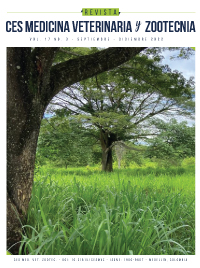Morphological and biomechanical description of the horse knee
DOI:
https://doi.org/10.21615/cesmvz.7008Keywords:
knee, joint, synovial, reciprocal, patellarAbstract
The knee is one of the largest synovial joints in the body and one of the most complex in its morphology and biomechanics. It is constituted by the contact point of bony, cartilaginous, ligamentous, vascular, and muscular structures that, when functioning in an integrated manner, allow granting an extensor, flexor and slight rotation capacity. The equine is characterized by having a patellar locking mechanism known as the reciprocal patellar system, which has the purpose of generating patellar resistance when it is positioned, generating a greater distribution of body weight at the level of the fixed joint, which allows the other pelvic limb to rest in a position of relaxation and semiflexion of the foot. The objective of the following study was to carry out a morphological description of the macroscopic anatomical structures that participate in the conformation of the equine knee joint and how they can allow a particular biomechanical functionality. For this, dissections of eight preserved equine knees were performed and the bone descriptions were of ten knees already worked through osteotechnics in the veterinary anatomy laboratory of the San Sebastián University, headquarters of Patagonia.
Downloads
References
Aspinall, Victoria; Cappello, Melanie; Bowden, Sally J. (2009). Introduction to Veterinary Anatomy and Physiology E-Book. London: Butterworth-Heinemann.
Saldivia Paredes, Manuel. (2018). Descripción morfológica y biomecánica de la articulación de la rodilla del canino (Canis lupus familiaris). CES Medicina Veterinaria y Zootecnia, 13 (3): 294-307. https://doi.org/10.21615/cesmvz.13.3.1
Barone, R. Anatomía comparada de los mamíferos domésticos. 1ª ed. Montevideo: hemisferio sur; 1987.
Sisson S, Grossman J. Anatomía de los animales domésticos. 5ª ed. Barcelona: Masson; 1999.
Köning H, Liebich H. Anatomía de los animales domésticos. 7th ed. Madrid: Médica Panamericana; 2020.
Concha AI. Anatomía del perro. Santiago: Universidad Santo Tomás; 2012.
Dyce KM, Sack WO, Wensing CJG. Anatomía veterina ria. 4ª ed. Ciudad de México: Manual Moderno; 2012
Budras KD, Sack WO, Röck S. Anatomy of the horse. Hannover: Schlütersche; 2009.
Frandson R, Spurgeon L. Anatomía y fisiología de los animales domésticos. 5ª ed. México: McGraw-Hill Inte ramericana; 1995.
Evans HE, de La Hunta A. Disección del perro. 5ª ed. Ciu dad de México: McGraw-Hill Interamericana; 2002.
C.F. Cox, M.A. Sinkler, J.B. Hubbard Anatomy, Bony Pelvis and Lower Limb Knee Patella, StatPearls, Treasure Island (FL) (2020).
Done SH, Goody PC, Evans SA, Stickland NC. Atlas en color de anatomía veterinaria. El perro y el gato. 2ª ed. Barcelona: Elsevier; 2010.
Shively M. Anatomía veterinaria básica, comparada y clínica. Ciudad de México: El Manual Moderno; 1993.
Smith BJ. Canine Anatomy. Virginia: Lippincott Williams & Wilkins; 1999.
Adams and Stashak’s Lameness in Horses, Seventh Edition. Edited by Gary M. Baxter. © 2020 John Wiley & Sons, Inc. Published 2020 by John Wiley & Sons, Inc.
Cuevas-Ramos G, Cova M, Arguelles D, Prades M. Anatomical variations of the equine popliteal tendon. J Vet Sci. 2019 Jul; 20 (4): e36. doi: 10.4142/jvs.2019.20.e36. PMID: 31364321; PMCID: PMC6669204.
Mow VC, Ratcliffe A,Chern KY,et al:Structure and Function Relationships of the Menisci of the Knee, in Mow VC, Arnoczky SP, Jackson DW (eds): Knee Meniscus Basic and Clinical Foundations. New York, NY, Raven Press, 1992, pp 37,57
Emery L, Miller J, Van Hoosen N. Horseshoeing Theory and Foot Care. Lea and Febiger, Philadelphia, 1977.
Voight M. Músculos skeletal interventions techniques for therapautic exercise. New york: McGraw Hill; 2007
Arthroscopy of the stifle. In: McIlwright CW, Wright I, Nixon A, Boening KJ (eds). Diagnostic and Surgical Arthroscopy in the Horse. 3rd ed. p. 178. Mosby Ltd., New York, 2005.
Jerram RM, Walker AM. Cranial cruciate ligament injury in the dog: pathophysiology, diagnosis and treatment. N Z Vet J. 2003 Aug; 51 (4): 149-58. doi: 10.1080/00480169.2003.36357. PMID: 16032317.
Espregueira-Mendes, da Silva MV. Anatomy of the lateral collateral ligament: a cadaver and histological study. Knee Surg Sports Traumatol Arthrosc. 2006 Mar;14 (3): 221-8. doi: 10.1007/s00167-005-0681-2. Epub 2005 Oct 12. PMID: 16220313.
M. Biscevic, M. Hebibovic, D. Smrke. Variations of femoral condyle shape Coll. Antropol., 29 (2005): 409-414.
Comerford EJ, Tarlton JF, Avery NC, Bailey AJ, Innes JF. Distal femoral intercondylar notch dimensions and their relationship to composition and metabolism of the canine anterior cruciate ligament. Osteoarthritis Cartilage. 2006 Mar; 14 (3): 273-8. doi: 10.1016/j.joca.2005.09.001. Epub 2005 Oct 20. PMID: 16242971.
G.A. Ateshian, L.J. Soslowsky, V.C. Mow. Quantitation of articular surface topography and cartilage thickness in knee joints using stereophotogrammetry. J. Biomech., 24 (1991): 761-7
Dyce KM, Sack WO, Wensing CJG. Anatomía veterinaria. 4.ª ed. Ciudad de México: Manual Moderno; 2012.
Fox AJ, Wanivenhaus F, Burge AJ, Warren RF, Rodeo SA. The human meniscus: a review of anatomy, function, injury, and advances in treatment. Clin Anat. 2015 Mar; 28 (2): 269-87. doi: 10.1002/ca.22456. Epub 2014 Aug 14. PMID: 25125315.
Johnson A, D Hulse. 2002. Part IV Orthopedics: Diseases of the Joints. In: Welch T(Ed). Small Animal Surgery. Second Edition, Pp 1023-1157.
Voight M. Músculos skeletal interventions techniques for therapautic exercise. New york: McGraw Hill; 2007.
Magge D. Othopedic physical assessment. 4 ed. Philadelphia: Saunders,2006.
Messner K. The menisci of the knee joint. Anatomical and functional characteristics, and a rationale for clinical treatment Sports Medicine, Faculty of Health Sciences, LinkoXping University, Sweden; 1998.
Escobar A, Tadich T. Caracterización biocinemática, al paso guiado a la mano, del caballo fino chilote. Arch. med. vet. [online].2006, 38 (1): 53-61. Disponibleen: https://www.scielo.cl/scielo.php?script=sci_arttext&pid=S0301-732X2006000100008. ISSN 0301-732X. http://dx.doi.org/10.4067/S0301-732X2006000100008.
Schuurman SO, Kersten W, Weijs WA. The equine hind limb is actively stabilized during standing. J Anat. 2003 Apr; 202 (4): 355-62. doi: 10.1046/j.1469-7580.2003.00166.x. PMID: 12739613; PMCID: PMC1571089.
Jiménez R, Isaza O. Plastinación, una técnica moderna al servicio de la anatomía. Iatreia. 2005; (18): 99-106.
Gómez, César Alfonso Muñetón and José Alejandro Ortiz. “Preparación en glicerina: una técnica para la conservación prolongada de cuerpos en anatomía veterinaria.” Revue De Medecine Veterinaire; 1 (2013): 115-122.
World Association of Veterinary Anatomists, World Association of Veterinary Anatomists. Nomina Anatómica Veterinaria. 2017.
Downloads
Published
How to Cite
Issue
Section
License
Copyright (c) 2023 CES Medicina Veterinaria y Zootecnia

This work is licensed under a Creative Commons Attribution-NonCommercial-ShareAlike 4.0 International License.
| Article metrics | |
|---|---|
| Abstract views | |
| Galley vies | |
| PDF Views | |
| HTML views | |
| Other views | |



